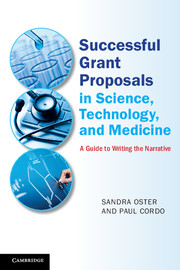Book contents
- Frontmatter
- Dedication
- Contents
- Preface and Acknowledgments
- 1 The Scientific Grant Proposal and Its Narrative
- 2 The Aims Section
- 3 The Background Section
- 4 The Preliminary Studies/Progress Report Section
- 5 The Methods Section, Part 1
- 6 The Methods Section, Part 2
- 7 Other prose considerations
- 8 Technical features of sentences
- Glossary
- Index
3 - The Background Section
Published online by Cambridge University Press: 05 September 2015
- Frontmatter
- Dedication
- Contents
- Preface and Acknowledgments
- 1 The Scientific Grant Proposal and Its Narrative
- 2 The Aims Section
- 3 The Background Section
- 4 The Preliminary Studies/Progress Report Section
- 5 The Methods Section, Part 1
- 6 The Methods Section, Part 2
- 7 Other prose considerations
- 8 Technical features of sentences
- Glossary
- Index
Summary
The Background Section provides an historical research context for your proposed research. When explaining this context, you need to review the previous research on your topic or research area, and then evaluate its strengths and weaknesses.
A strong Background Section helps reviewers understand that your proposed research is not arbitrary, but the logical outgrowth of previous research. A strong Background Section also helps you persuade reviewers that your proposed research is significant and novel. It is not surprising that NIH has divided its former Background Section into 2 major sections: Significance and Innovation. In contrast to NIH, NSF typically provides little guidance in structuring the Background Section (or the Aims Section), but does identify the need to address the state of knowledge in the field and significance:
The Project Description should provide a clear statement of the work to be undertaken and must include: objectives for the period of the proposed work and expected significance; relation to longer-term goals of the PI’s project; and relation to the present state of knowledge in the field, to work in progress by the PI under other support and to work in progress elsewhere. (emphasis added)
Perhaps due to NSF’s general guidance on the Background Section (and the Aims Section), it is not unusual for the initial section of an NSF narrative to be composed of information equivalent to information in both the Aims and Background Sections (see Chapters 2 and 3). However, most funding agencies still require separate Aims and Background Sections. Before writing the Background Section, you need to review submission requirements from your targeted funding agency and follow them.
- Type
- Chapter
- Information
- Successful Grant Proposals in Science, Technology, and MedicineA Guide to Writing the Narrative, pp. 68 - 97Publisher: Cambridge University PressPrint publication year: 2015



